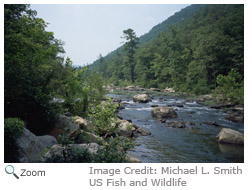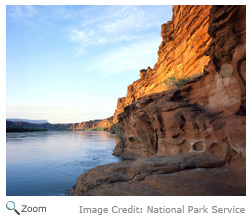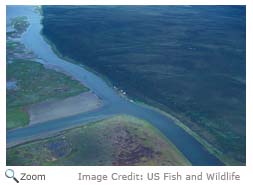Rivers and Streams
 Rivers come in lots of different shapes and sizes, but they all have some things in common. All rivers and streams start at some high point. The high point can be a mountain, hill, or other elevated area. Water from some source like a spring, snow melt, or a lake starts at this high point and begins to flow down to lower points. As the water flows down, it may pick up more water from other small streams, springs or or from rain or snow melt. These streams may slowly join together to form a larger stream or river. Small rivers and streams may join together to become larger rivers. Eventually all this water from rivers and streams will run into the ocean or an inland body of water like a lake. Rivers come in lots of different shapes and sizes, but they all have some things in common. All rivers and streams start at some high point. The high point can be a mountain, hill, or other elevated area. Water from some source like a spring, snow melt, or a lake starts at this high point and begins to flow down to lower points. As the water flows down, it may pick up more water from other small streams, springs or or from rain or snow melt. These streams may slowly join together to form a larger stream or river. Small rivers and streams may join together to become larger rivers. Eventually all this water from rivers and streams will run into the ocean or an inland body of water like a lake.
It's All Connected
 From
space, rivers and streams look like veins on the Earth's surface. Rivers
and streams connect with each other in a system called a watershed. There
are three types of watersheds. The rivers and streams in a closed
watershed empty into an inland body of water like a lake. Open
watersheds empty into the ocean from one source. Multiple
open watersheds empty into the ocean form more than one source. Within watershed areas you will find other wetland areas like ponds, swamps
and marshes. From
space, rivers and streams look like veins on the Earth's surface. Rivers
and streams connect with each other in a system called a watershed. There
are three types of watersheds. The rivers and streams in a closed
watershed empty into an inland body of water like a lake. Open
watersheds empty into the ocean from one source. Multiple
open watersheds empty into the ocean form more than one source. Within watershed areas you will find other wetland areas like ponds, swamps
and marshes.
|
|
Wear
and Tear
 Rivers both carve the land and build it up. As rivers flow, they cut into the land. This is called erosion. Rivers cut both down into and across the earth. As rivers cut into the earth, they grind up rocks and churn up small rocks and soil. Over time rivers change the land they flow over by carving new paths for themselves. All of the rocks, pebbles and soil that rivers churn up get carried downstream. As the river flows, it deposits all of the stuff it carries. Large items like rocks get deposited first. Soil is deposited last. Over time the soil that a river deposits can build up and create new land areas! Rivers both carve the land and build it up. As rivers flow, they cut into the land. This is called erosion. Rivers cut both down into and across the earth. As rivers cut into the earth, they grind up rocks and churn up small rocks and soil. Over time rivers change the land they flow over by carving new paths for themselves. All of the rocks, pebbles and soil that rivers churn up get carried downstream. As the river flows, it deposits all of the stuff it carries. Large items like rocks get deposited first. Soil is deposited last. Over time the soil that a river deposits can build up and create new land areas!
End of the Road
 River deltas are land areas that are formed at the mouth or end of a river as the minerals and soil the river carries are deposited. Deltas are very rich in nutrients. Some of the best farmland on Earth can be found in river deltas. River deltas are land areas that are formed at the mouth or end of a river as the minerals and soil the river carries are deposited. Deltas are very rich in nutrients. Some of the best farmland on Earth can be found in river deltas.
Importance of Rivers
 Although river water makes up only about 0.2 percent of all the fresh water on Earth, it plays a very important role. Rivers are like roads. They carry water, organisms and important gases and nutrients to many areas. They also help drain rainwater and provide habitats for many species of plants and animals. As they make their way to the sea, rivers help shape the features of the Earth. Rivers are travel routes for people and provide the power for hydroelectric plants. Although river water makes up only about 0.2 percent of all the fresh water on Earth, it plays a very important role. Rivers are like roads. They carry water, organisms and important gases and nutrients to many areas. They also help drain rainwater and provide habitats for many species of plants and animals. As they make their way to the sea, rivers help shape the features of the Earth. Rivers are travel routes for people and provide the power for hydroelectric plants.
|